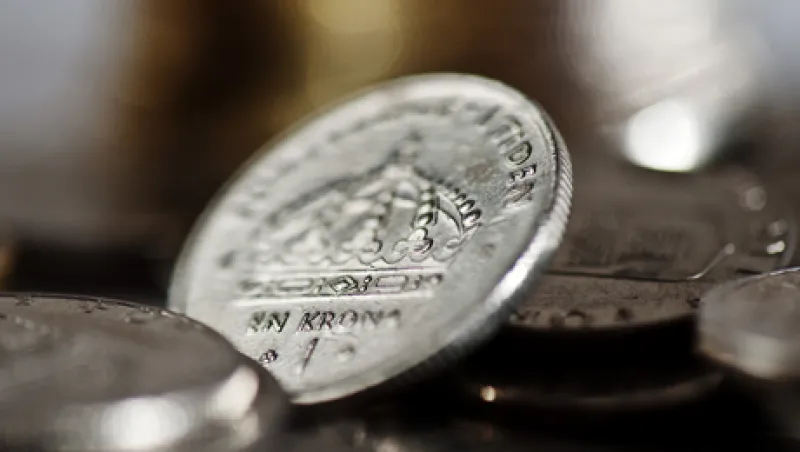The Swedish krona soared to a 12-year high against the euro this week, as investors traded on its well-established sensitivity to global equity market performance. But what are its long-term prospects?
Buying the krona has conventionally been seen as a useful proxy for buying international, export-focused stocks because of the international exposure of the companies that dominate the country’s stock market. Ericcson, the telecoms equipment manufacturer, makes only about 3 percent of its revenue in Sweden. Electrolux, the domestic appliance maker, relies on foreign sales for all but 2 percent.
Because of Swedish companies’ international focus the krona has tended in the recent past to correlate particularly well with the U.S. S&P 500 stock index. True to form, the S&P and the Swedish currency have risen in tandem in the past few weeks on growing optimism about the U.S. economy, combined with hopes of renewed European Central Bank activism to allay the euro zone crisis. The S&P was up 7 percent since the beginning of June at 1,401 when European trading closed on Thursday. Over the same period the krona was 8 percent higher against both the greenback and the European single currency, with rates at the European close of 6.7 krona to the dollar and 8.2 to the euro.
However, structural forces are also boosting the krona. Exports leapt by 2.1 percent in the second quarter — aided by Sweden’s low trade exposure to the peripheral euro zone countries. Sweden’s biggest customer for goods exports is Germany, which buys about 10 percent of its merchandise. Demand from Germany is resilient thanks to the underlying strength of its economy. Sweden also exports more to China than to Italy.
Exports have supported the stock market as well as the currency: The OMX Stockholm 30 index has appreciated by 10 percent since the beginning of the year. The combination of strong exports and steady domestic demand enabled the economy as a whole to grow by 2.3 percent year-on-year in the second quarter, shoring up the tax base and keeping the country on track to meet the International Monetary Fund’s forecast that the country will, as it did last year, remain neither in deficit nor in surplus. This strengthens the krona by reducing fears that the Riksbank will be forced to print money to fund a fiscal gap.
Sweden’s high interest rates have also buoyed the currency. At 1.5 percent, the Riksbank’s benchmark rate is 75 basis points above the European Central Bank’s.
The krona “has both cyclical and structural forces propelling its move higher,” said HSBC in a recent note. “In a world of so many ugly currencies” — ugly because of poor economic fundamentals — “this combination can be very powerful.” HSBC listed renewed global equity strength among the short-term drivers and Sweden’s favorable fiscal and international trade positions among the long-term forces.
The Riksbank’s relaxed attitude towards the krona’s appreciation is crucial to its firmness. The minutes of its latest monetary policy meeting in July show the krona’s value as low on the list of items the central bank is fretting over. This is in sharp contrast to Switzerland, where the central bank has aggressively resisted currency appreciation. In a recent note, Nomura suggested the krona was likely to find long-term support because the central bank seemed “relatively content with SEK [Swedish krona] strength.”
However, there are limits to how high the krona can go before one of two of things is likely to happen. One possibility is that the value of the krona rises high enough to hurt economic growth by making exports uncompetitive. A second possibility is that the Riksbank starts to worry that this will happen and preempts it by reversing its present policy of benign neglect towards the currency.
One way of calculating the juncture at which this tipping point might be reached is to work out fair value — the long-term, intrinsic value of a currency. A common method is to use purchasing power parity (PPP): how many goods and services that currency could buy in its home country, compared with other currencies in their own countries. Based on the Organization for Economic Cooperation and Development’s assessment of PPP — last updated this month — the Swedish krona is more than 30 percent overvalued against the euro and the dollar.
Currencies can trade above or below fair value for a long time. Moreover, the strong export figures suggest that by the end of June, at least, the krona had not risen sufficiently high to damage trade — though the currency has appreciated further since then against the euro and dollar. The more specialist, high-tech Swedish exporters are relatively well insulated from the rise in the krona because competition in their markets is based more on quality than price.
Nevertheless, fair value tends eventually to exert a magnetic effect, pulling the currency back closer to a level which tallies with the price of goods in the real world. The PPP calculations certainly suggest it will henceforth be harder for the krona to appreciate further.
HSBC’s year-end forecast of 8.1 krona to the euro — only a smidgeon away from its present value — also suggests the end may be near when it comes to krona appreciation. A rise significantly above that would render it expensive, making it “very likely that policy makers would object,” says HSBC. In any case, an equally abrupt reversal of the past week’s abrupt rise in global equity markets, provoked by another piece of bad news from the euro zone, is likely to push the currency down again. This would save the Riksbank the trouble of worrying whether it is too high.






